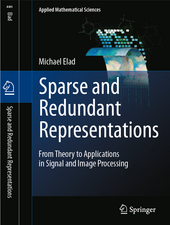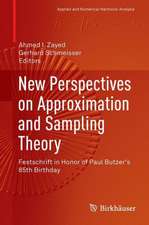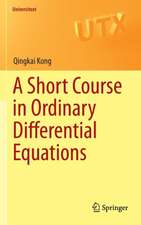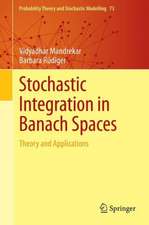Multivariate Polysplines: Applications to Numerical and Wavelet Analysis
Autor Ognyan Kouncheven Limba Engleză Hardback – 11 iun 2001
Multivariate polysplines have applications in the design of surfaces and "smoothing" that are essential in computer aided geometric design (CAGD and CAD/CAM systems), geophysics, magnetism, geodesy, geography, wavelet analysis and signal and image processing. In many cases involving practical data in these areas, polysplines are proving more effective than well-established methods, such as kKriging, radial basis functions, thin plate splines and minimum curvature.
- Part 1 assumes no special knowledge of partial differential equations and is intended as a graduate level introduction to the topic
- Part 2 develops the theory of cardinal Polysplines, which is a natural generalization of Schoenberg's beautiful one-dimensional theory of cardinal splines
- Part 3 constructs a wavelet analysis using cardinal Polysplines. The results parallel those found by Chui for the one-dimensional case
- Part 4 considers the ultimate generalization of Polysplines - on manifolds, for a wide class of higher-order elliptic operators and satisfying a Holladay variational property
Preț: 566.86 lei
Preț vechi: 776.53 lei
-27% Nou
Puncte Express: 850
Preț estimativ în valută:
108.47€ • 113.03$ • 89.81£
108.47€ • 113.03$ • 89.81£
Carte tipărită la comandă
Preluare comenzi: 021 569.72.76
Specificații
ISBN-13: 9780124224902
ISBN-10: 0124224903
Pagini: 498
Dimensiuni: 172 x 244 x 28 mm
Greutate: 1.15 kg
Editura: ELSEVIER SCIENCE
ISBN-10: 0124224903
Pagini: 498
Dimensiuni: 172 x 244 x 28 mm
Greutate: 1.15 kg
Editura: ELSEVIER SCIENCE
Public țintă
Graduate students, academics, professionals and researchers in Applied Mathematics. Also engineers and researchers in geophysics, geography and physicsCuprins
Preface1 Introduction 1.1 Organization of Material 1.1.1 Part I: Introduction of Polysplines 1.1.2 Part II: Cardinal Polysplines 1.1.3 Part III: Wavelet Analysis Using Polysplines 1.1.4 Part IV: Polysplines on General Interfaces 1.2 Audience 1.3 Statements 1.4 Acknowledgements 1.5 The Polyharmonic Paradigm 1.5.1 The Operator, Object and Data Concepts of the Polyharmonic Paradigm 1.5.2 The Taylor FormulaPart I Introduction to Polysplines 2 One-Dimensional Linear and Cubic Splines 2.1 Cubic Splines 2.2 Linear Splines 2.3 Variational (Holladay) Property of the Odd-Degree Splines 2.4 Existence and Uniqueness of Odd-Degree Splines 2.5 The Holladay Theorem 3 The Two-Dimensional Case: Data and Smoothness Concepts 3.1 The Data Concept in Two Dimensions According to the Polyharmonic Paradigm 3.2 The Smoothness Concept According to the Polyharmonic Paradigm 4 The Objects Concept: Harmonic and Polyharmonic Functions in Rectangular Domains in ℝ2 4.1 Harmonic Functions in Strips or Rectangles 4.2 “Parametrization of the Space of Periodic Harmonic Functions in the Strip: the Dirichlet Problem 4.3 “Parametrization of the Space of Periodic Polyharmonic Functions in the Strip: the Dirichlet Problem 4.4 Nonperiodicity in y 5 Polysplines on Strips in ℝ2 5.1 Periodic Harmonic Polysplines on Strips, p = 5.2 Periodic Biharmonic Polysplines on Strips, p = 5.3 Computing the Biharmonic Polysplines on Strips 5.4 Uniqueness of the Interpolation Polysplines 6 Application of Polysplines to Magnetism and CAGD 6.1 Smoothing Airborne Magnetic Field Data 6.2 Applications to Computer-Aided Geometric Design 6.3 Conclusions 7 The Objects Concept: Harmonic and Polyharmonic Functions in Annuli in ℝ2 7.1 Harmonic Functions in Spherical (Circular) Domains 7.2 Biharmonic and Polyharmonic Functions 7.3 “Parametrization of the Space of Polyharmonic Functions in the Annulus and Ball: the Dirichlet Problem 8 Polysplines on annuli in ℝ2 8.1 The Biharmonic Polysplines, p = 2 8.2 Radially Symmetric Interpolation Polysplines 8.3 Computing the Polysplines for General (Nonconstant) Data 8.4 The Uniqueness of Interpolation Polysplines on Annuli 8.5 The change v = log r and the Operators Mk,p 8.6 The Fundamental Set of Solutions for the Operator Mk,p(d/dv) 9 Polysplines on Strips and Annuli in ℝn 9.1 Polysplines on Strips in ℝn 9.2 Polysplines on Annuli in ℝn 10 Compendium on Spherical Harmonics and Polyharmonic Functions 10.1 Introduction 10.2 Notations 10.3 Spherical Coordinates and the Laplace Operator 10.4 Fourier Series and Basic Properties 10.5 Finding the Point of View 10.6 Homogeneous Polynomials in ℝn 10.7 Gauss Pepresentation of Homogeneous Polynomials 10.8 Gauss Representation: Analog to the Taylor Series, the Polyharmonic Paradigm 10.9 The Sets ℋk are Eigenspaces for the Operator ∆θ 10.10 Completeness of the Spherical Harmonics in L2(??n-1) 10.11 Solutions of ∆w(x) = 0 with Separated Variables 10.12 Zonal Harmonics : the Functional Approach 10.13 The Classical Approach to Zonal Harmonics 10.14 The Representation of Polyharmonic Functions Using Spherical Harmonics 10.15 The Operator is Formally Self-Adjoint 10.16 The Almansi Theorem 10.17 Bibliographical Notes 11 Appendix on Chebyshev Splines 11.1 Differential Operators and Extended Complete Chebyshev Systems 11.2 Divided Differences for Extended Complete Chebyshev Systems 11.3 Dual Operator and ECT-System 11.4 Chebyshev Splines and One-Sided Basis 11.5 Natural Chebyshev Splines 12 Appendix on Fourier Series and Fourier Transform 12.1 Bibliographical Notes Bibliography to Part IPart II Cardinal Polysplines in ℝn 13 Cardinal L-Splines According to Micchelli 13.1 Cardinal L-Splines and the Interpolation Problem 13.2 Differential Operators and their Solution Sets UZ+1 13.3 Variation of the Set UZ+1[Λ] with Λ and Other Properties 13.4 The Green Function (x) of the Operator ℒZ+1 13.5 The Dictionary: L-Polynomial Case 13.6 The Generalized Euler Polynomials AZ(x; λ) 13.7 Generalized Divided Difference Operator 13.8 Zeros of the Euler–Frobenius Polynomial ΠZ(λ) 13.9 The Cardinal Interpolation Problem for L-Splines 13.10 The Cardinal Compactly Supported L-Splines QZ+1 13.11 Laplace and Fourier Transform of the Cardinal TB-Spline QZ+1 13.12 Convolution Formula for Cardinal TB-Splines 13.13 Differentiation of Cardinal TB-Splines 13.14 Hermite–Gennocchi-Type Formula 13.15 Recurrence Relation for the TB-Spline 13.16 The Adjoint Operator ℒ*Z+1 and the TB-Spline Q*Z+1(x) 13.17 The Euler Polynomial AZ(x; λ) and the TB-Spline QZ+1(x) 13.18 The Leading Coefficient of the Euler–Frobenius Polynomial ΠZ(λ) 13.19 Schoenberg’s “Exponential Euler L-Spline ΦZ(x; λ) and AZ(x; λ) 13.20 Marsden’s Identity for Cardinal L-Splines 13.21 Peano Kernel and the Divided Difference Operator in the Cardinal Case 13.22 Two-Scale Relation (Refinement Equation) for the TB-Splines QZ+1[Λ; h] 13.23 Symmetry of the Zeros of the Euler–Frobenius Polynomial ΠZ(λ) 13.24 Estimates of the Functions AZ(x; λ) and QZ+1(x) 14 Riesz Bounds for the Cardinal L-Splines QZ+1 14.1 Summary of Necessary Results for Cardinal L-Splines 14.2 Riesz Bounds 14.3 The Asymptotic of AZ(0; λ) in k 14.4 Asymptotic of the Riesz Bounds A, B 14.5 Synthesis of Compactly Supported Polysplines on Annuli 15 Cardinal interpolation Polysplines on annuli 287 15.1 Introduction 15.2 Formulation of the Cardinal Interpolation Problem for Polysplines 15.3 α = 0 is good for all L-Splines with L = Mk,p 15.4 Explaining the Problem 15.5 Schoenberg’s Results on the Fundamental Spline L(X) in the Polynomial Case 15.6 Asymptotic of the Zeros of ΠZ(λ; 0) 15.7 The Fundamental Spline Function L(X) for the Spherical Operators Mk,p 15.8 Synthesis of the Interpolation Cardinal Polyspline 15.9 Bibliographical Notes Bibliography to Part IIPart III Wavelet Analysis 16 Chui’s Cardinal Spline Wavelet Analysis 16.1 Cardinal Splines and the Sets Vj 16.2 The Wavelet Spaces Wj 16.3 The Mother Wavelet ψ 16.4 The Dual Mother Wavelet ψ 16.5 The Dual Scaling Function φ 16.6 Decomposition Relations 16.7 Decomposition and Reconstruction Algorithms 16.8 Zero Moments 16.9 Symmetry and Asymmetry 17 Cardinal L-Spline Wavelet Analysis 17.1 Introduction: the Spaces Vj and Wj 17.2 Multiresolution Analysis Using L-Splines 17.3 The Two-Scale Relation for the TB-Splines QZ+1(x) 17.4 Construction of the Mother Wavelet ψh 17.5 Some Algebra of Laurent Polynomials and the Mother Wavelet ψh 17.6 Some Algebraic Identities 17.7 The Function ψh Generates a Riesz Basis of W0 17.8 Riesz Basis from all Wavelet Functions ψ(x) 17.9 The Decomposition Relations for the Scaling Function QZ+1 17.10 The Dual Scaling Function φ and the Dual Wavelet ψ 17.11 Decomposition and Reconstruction by L-Spline Wavelets and MRA 17.12 Discussion of the Standard Scheme of MRA 18 Polyharmonic Wavelet Analysis: Scaling and Rotationally Invariant Spaces 18.1 The Refinement Equation for the Normed TB-Spline QZ+1 18.2 Finding the Way: some Heuristics 18.3 The Sets PVj and Isomorphisms 18.4 Spherical Riesz Basis and Father Wavelet 18.5 Polyharmonic MRA 18.6 Decomposition and Reconstruction for Polyharmonic Wavelets and the Mother Wavelet 18.7 Zero Moments of Polyharmonic Wavelets 18.8 Bibliographical Notes Bibliography to Part IIIPart IV Polysplines for General Interfaces 19 Heuristic Arguments 19.1 Introduction 19.2 The Setting of the Variational Problem 19.3 Polysplines of Arbitrary Order p 19.4 Counting the Parameters 19.5 Main Results and Techniques 19.6 Open Problems 20 Definition of Polysplines and Uniqueness for General Interfaces 20.1 Introduction 20.2 Definition of Polysplines 20.3 Basic Identity for Polysplines of even Order p = 2q 20.4 Uniqueness of Interpolation Polysplines and Extremal Holladay-Type Property 21 A Priori Estimates and Fredholm Operators 21.1 Basic Proposition for Interface on the Real Line 21.2 A Priori Estimates in a Bounded Domain with Interfaces 21.3 Fredholm Operator in the Space H2p+r(D\ST ) for r ≥ 0 22 Existence and Convergence of Polysplines 22.1 Polysplines of Order 2q for Operator L = L 22.2 The Case of a General Operator L 22.3 Existence of Polysplines on Strips with Compact Data 22.4 Classical Smoothness of the Interpolation Data gj 22.5 Sobolev Embedding in Ck,α 22.6 Existence for an Interface which is not C∞ 22.7 Convergence Properties of the Polysplines 22.8 Bibliographical Notes and Remarks 23 Appendix on Elliptic Boundary Value Problems in Sobolev and Hölder Spaces 23.1 Sobolev and Hölder Spaces 23.2 Regular Elliptic Boundary Value Problems 23.3 Boundary Operators, Adjoint Problem and Green Formula 23.4 Elliptic Boundary Value Problems 23.5 Bibliographical Notes 24 Afterword Bibliography to Part IVIndex


















